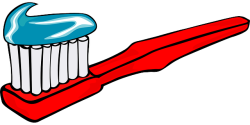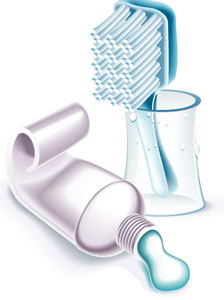By Aalia Anderson
 From the time you were a little kid and mom or dad helped you put that fabulously pink or blue sparkling toothpaste on your elaborately decorated cartoon-themed toothbrush, you knew that brushing your teeth was important. It is impossible to overestimate the importance of good oral hygiene, the key to keeping your teeth and gums in check, and to maintaining not only good dental health but your overall well-being. When toothbrushes first came out 80 years ago, everyone used the same one. Now, most supermarkets and pharmacies have an entire shelf dedicated to dental care, and the choices can be overwhelming. Here are 5 steps to navigating the toothbrush aisles and walking out with the right choice for you.
From the time you were a little kid and mom or dad helped you put that fabulously pink or blue sparkling toothpaste on your elaborately decorated cartoon-themed toothbrush, you knew that brushing your teeth was important. It is impossible to overestimate the importance of good oral hygiene, the key to keeping your teeth and gums in check, and to maintaining not only good dental health but your overall well-being. When toothbrushes first came out 80 years ago, everyone used the same one. Now, most supermarkets and pharmacies have an entire shelf dedicated to dental care, and the choices can be overwhelming. Here are 5 steps to navigating the toothbrush aisles and walking out with the right choice for you.
1. Find the right size
The best toothbrush for will have a head that will allow you easy access to all surfaces of your teeth. A toothbrush head that is too big for your mouth may be difficult to maneuver around those hard to reach areas, such as the sides and backs of your molars. Make sure the toothbrush also has a long enough handle, and maybe some gel cushioning for your thumb to make for a more comfortable brushing experience. Some experts say it should be as comfortable as holding a fork when you eat.
2. Choose the right bristles
Toothbrushes come with soft, medium, or hard nylon bristles. For the large majority of you, the most comfortable and safest choice will be a soft-bristled toothbrush. Medium to hard-bristled brushes could actually damage your protective tooth enamel, the gums, and root surface of your teeth, depending on how vigorously you brush them and how strong your teeth are. For the best tooth protection, it’s important to make sure the bristles on your decided toothbrush have rounded tips.
3. Expert Advice
Ask your dentist for a recommendation. He or she will know whether a toothbrush has been quality-control tested for proper cleaning effectiveness and safety. If that isn’t accessible to you, on your next trip to the supermarket or chemist, look for the American Dental Association (ADA) Seal of Approval. In disposable toothbrushes, this seal ensures safe tips, sturdy and durable bristles, a sturdy handle, and a toothbrush that will effectively reduce plaque build-up and gum disease. If you are thinking about electric toothbrushes, the seal ensures that they undergo additional safety testing in an independent lab to prove that they are safe for use on the tissues of your mouth and teeth, and any dental hardware that may be in place as well. What you do NOT want to do is buy a no-name dollar store toothbrush.
4. Invest in an Electric Toothbrush
 Now that I’ve got you thinking about electric toothbrushes, let me explain why they might be the best choice for you. Dentists everywhere overwhelmingly recommend them as the best way to keep your teeth clean and plaque-free. You can buy the toothbrush heads in various shapes and sizes, and they all work differently, some oscillating, some vibrating, and some rotating. They also come with a lot of bonus features, like special modes for sensitive teeth, gum massaging, or even whitening. Some even come with pressure sensors that will let you know if you’re brushing too hard, and feature digital reminders to replace your toothbrush head! [source: Oral B]. Most are even packed with extras like toothbrush holders and travel chargers. With all these fancy tricks and frills, it’s no surprise that electrical toothbrushes sport a much higher price tag than manual ones. Starter kits are generally $50 to $75, although some can be as low as $25 or as much as $100 or more. But thinking long term, they most likely won’t cost much more than manual brushes, as they don’t need to be replaced as often. Most importantly, their benefits will really outweigh their costs: they can remove plaque and stains more effectively, are gentle on your gums and teeth, easier to use, can give your gums a gentle massage, and are a lot more fun than a manual toothbrush!
Now that I’ve got you thinking about electric toothbrushes, let me explain why they might be the best choice for you. Dentists everywhere overwhelmingly recommend them as the best way to keep your teeth clean and plaque-free. You can buy the toothbrush heads in various shapes and sizes, and they all work differently, some oscillating, some vibrating, and some rotating. They also come with a lot of bonus features, like special modes for sensitive teeth, gum massaging, or even whitening. Some even come with pressure sensors that will let you know if you’re brushing too hard, and feature digital reminders to replace your toothbrush head! [source: Oral B]. Most are even packed with extras like toothbrush holders and travel chargers. With all these fancy tricks and frills, it’s no surprise that electrical toothbrushes sport a much higher price tag than manual ones. Starter kits are generally $50 to $75, although some can be as low as $25 or as much as $100 or more. But thinking long term, they most likely won’t cost much more than manual brushes, as they don’t need to be replaced as often. Most importantly, their benefits will really outweigh their costs: they can remove plaque and stains more effectively, are gentle on your gums and teeth, easier to use, can give your gums a gentle massage, and are a lot more fun than a manual toothbrush!
5. Know when to repair your toothbrush
For disposable toothbrushes, the American Dental Association recommends replacing your toothbrush every 3 to 4 months, or sooner if the bristles are starting to look frayed. Once they start to break apart and lose their normal flexibility, change your toothbrush – a visual inspection is better to go by than a strict timeline. It’s also important to change your toothbrush after you’ve had a cold, since the bristles may have collected germs that could lead to future reinjection. Whatever you do, and whichever toothbrush you choose, always makes sure to brush your teeth twice daily, for at least two minutes a session, using the proper technique. Happy brushing!
– Aalia Anderson is a Melbourne – based writer and blogger who is also an avid twice daily tooth brusher. She is a longtime patient of Chatswood Dentists and gathered a lot of valuable information for this post from the experts at their boutique dental practice. They have helped her develop an individually designed home care and dental health maintenance program, and have guided her well in choosing the perfect toothbrush every time!
